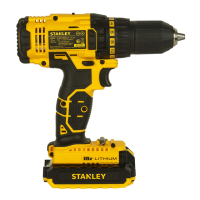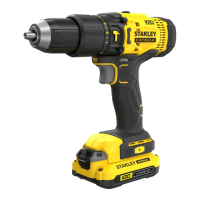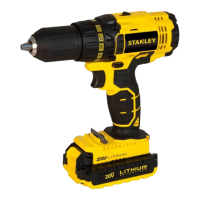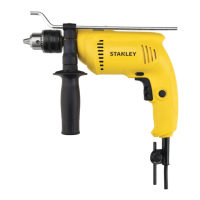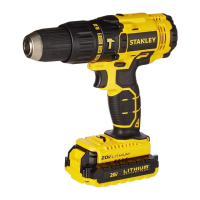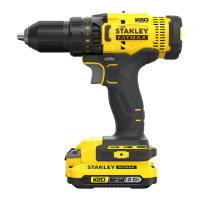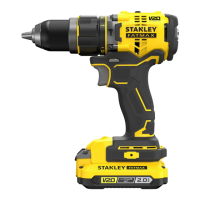5. Power tool use and care
a. Do not force the power tool. Use the correct power
tool for your application. The correct power tool will
do the job better and safer at the rate for which it was
designed.
b. Do not use the power tool if the switch does not
turn it on and off. Any power tool that cannot be
controlled with the switch is dangerous and must be
repaired.
c. Disconnect the plug from the power source and/
or the battery pack from the power tool before
making any adjustments, changing accessories,
or storing power tools. Such preventive safety
measures reduce the risk of starting the power tool
accidentally.
d. Store idle power tools out of the reach of children
and do not allow persons unfamiliar with the
power tool or these instructions to operate the
power tool. Power tools are dangerous in the hands of
untrained users.
6. Service
a. Have your power tool serviced by a qualified
repair person using only identical replacement
parts. This will ensure that the safety of the power tool
is maintained.
ADDITIONAL POWER TOOL SAFETY WARNINGS
WARNING! Additional safety warnings for drills and drill/
drivers.
♦ Wear ear protectors with impact drills. Exposure to
noise can cause hearing loss.
♦ Use auxiliary handles supplied with the tool. Loss of
control can cause personal injury.
♦ Hold power tool by insulated gripping surfaces when
performing an operation where the cutting accessory
may contact hidden wiring. Cutting accessory
contacting a “Live” wire may make exposed metal parts
of the power tool “Live” and could give the operator an
electric shock.
♦ Hold power tool by insulated gripping surfaces when
performing an operation where the fastener may
contact hidden wiring. Fasteners contacting a “Live”
wire may make exposed metal parts of the power tool
“Live” and could give the operator an electric shock.
♦ Use clamps or another practical way to secure and
support the work piece to a stable platform. Holding the
work by hand or against your body leaves it unstable
and may lead to loss of control.
♦ Before drilling into walls, floors or ceilings, check for the
location of wiring and pipes.
♦ Avoid touching the tip of a drill bit just after drilling, as
it may be hot.
♦ This tool is not intended for use by persons (including
children) with reduced physical, sensory or mental
capabilities, or lack of experience and knowledge,
unless they have been given supervision or instruction
concerning use of the appliance by a person responsible
for their safety. Children should be supervised to ensure
that they do not play with the appliance. The intended
use is described in this instruction manual. The use of
any accessory or attachment or performance of any
operation with this tool other than those recommended
in this instruction manual may present a risk of personal
injury and/or damage to property.
SAFETY OF OTHERS
♦ This appliance is not intended for use by persons
(including children) with reduced physical, sensory
or mental capabilities, or lack of experience and
knowledge, unless they have been given supervision or
instruction concerning use of the appliance by a person
responsible for their safety.
♦ Children should be supervised to ensure that they do
not play with the appliance.
RESIDUAL RISKS
Additional residual risks may arise when using the tool
which may not be included in the enclosed safety warnings.
These risks can arise from misuse, prolonged use etc.
Even with the application of the relevant safety regulations
and the implementation of safety devices, certain residual
risks cannot be avoided. These include:
♦ Injuries caused by touching any rotating/moving parts.
♦ Injuries caused when changing any parts, blades or
accessories.
♦ Injuries caused by prolonged use of a tool. When using
any tool for prolonged periods ensure you take regular
breaks.
♦ Impairment of hearing.
♦ Health hazards caused by breathing dust developed
when using your tool (example: working with wood,
especially oak, beech and MDF.)
ADDITIONAL SAFETY INSTRUCTIONS
FOR BATTERIES AND CHARGERS
BATTERIES
♦ Never attempt to open for any reason.
♦ Do not expose the battery to water.
♦ Do not store in locations where the temperature may
exceed 40°C.
♦ Charge only at ambient temperatures between 10°C
and 40°C.
♦ Charge only using the charger provided with the tool.
♦ When disposing of batteries, follow the instructions
given in the section “Protecting the environment”.
♦ Do not attempt to charge damaged batteries.
CHARGERS
♦ Use your STANLEY charger only to charge the battery
in the tool with which it was supplied. Other batteries
could burst, causing personal injury and damage.
♦ Never attempt to charge non-rechargeable batteries.
♦ Have defective cords replaced immediately.
♦ Do not expose the charger to water.
♦ Do not open the charger.
♦ Do not probe the charger.
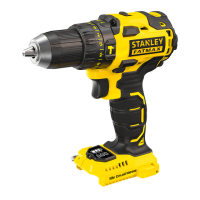
